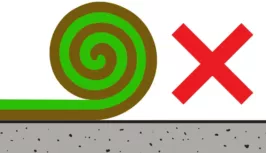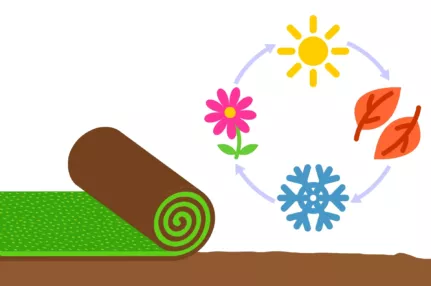Common Turfing Mistakes

Whether you’re an expert or novice gardener, laying turf is one of the easiest and quickest ways to get a brand new, lush-looking lawn. However, even the most experienced landscapers can end up making simple mistakes that may affect the health and quality of the lawn.
Here are Online Turf’s top 4 turfing mistakes you should look to avoid for a successful turf laying experience.
1. Laying turf onto unsuitable ground
A common mistake we often see is laying turf onto an unsuitable base. For example, sand, grass, concrete and weed control membranes are all likely to hinder your turf’s growth by blocking the plant roots from developing down into the ground below.
You should only lay turf onto good quality topsoil so that the roots are able to easily penetrate the soil & access the nutrients it needs to survive.



If you are laying turf onto a mixture of soil and sand (also known as ‘topdressing’) you should ensure that there is appropriate drainage so that the soil does not become waterlogged and that the sand does not absorb too much moisture away from the roots, drying out the turf.
2. Laying turf onto poor soil quality
Laying turf onto the correct ground is a good start for healthy turf growth but you also need to ensure that the soil it’s being laid onto is of good quality. Signs of poor-quality soil would be:
- Containing
large debris like big rocks, stones or weeds.
- Having a claggy
and clay-like texture that allows water puddles to form.
- Being dry,
cracked and impenetrable.
Having some small stones in your soil shouldn't be an issue as this can help with drainage.
Your soil should be soft enough to support the turf rooting into the ground and moist enough to provide a steady source of water and nutrients to the plant. You can add fresh topsoil to help level out areas that are uneven, or to mix in with clay soil to make a new, more suitable mixture to lay your turf onto.
If you need further information on how to prepare your ground for laying turf you can check out our how-to video guide.
3. Not laying quick enough
As turf is a perishable product, one of the most common mistakes we see is not laying it fast enough. Turf that has been left to deteriorate on a pallet can appear yellow / brown or, in some extreme cases, dark brown, smelly and mouldy. The latter is a sign of dead, unrecoverable turf.
We will always recommend laying turf the same
day of delivery for the best results, but we understand that sometimes, this
isn’t possible, so we’ve provided seasonal recommendations for the appropriate
turf-laying times below:

Spring: You should aim to lay on the same day as delivery, or within 1 day of delivery.
Summer: In hotter temperatures, it is imperative that you lay turf on the same day of delivery. If you need to leave the turf overnight, we recommend removing the top few layers of turf from the pallet to encourage airflow. You should then lay first thing the next morning.
Autumn: You should aim to lay on the same day as delivery, or within 1 day of delivery.
Winter: You should aim to lay on the same day as delivery, or within 1-2 days after delivery. You should not lay onto frozen ground.
4. Incorrect aftercare
Once the turf has been laid, it’s important you provide it with the correct aftercare to ensure that it successfully roots in. Watering is key to a surviving, thriving turf. The best way to care for a lawn is to follow its immediate needs and use the weather / season as a guide for your watering schedule.
In hot weather, you should water heavily and ideally in in the morning and evening before the sun is directly overhead. You should not water turf on the pallet in periods of hot weather, or cover it with a tarp, as this can make the turf overheat and sweat. In periods of heavy rain, you may not need to water the lawn as much, or you could risk waterlogging the turf.
Other forms of aftercare mistakes would be over-fertilising your turf, which can scorch the grass in hot weather or negatively affect the soil’s PH. You should also be wary of mowing too short, as this can scalp the lawn and damage the blades beyond recovery.


